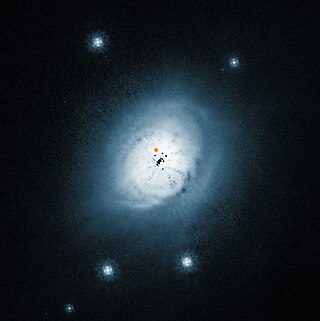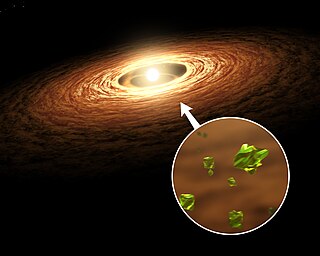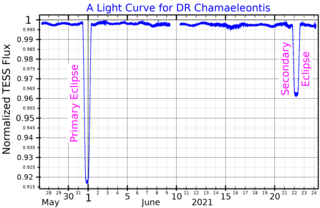HD 142 is a wide binary star system in the southern constellation of Phoenix. The main component has a yellow-white hue and is dimly visible to the naked eye with an apparent visual magnitude of 5.7. The system is located at a distance of 85.5 light years from the Sun based on parallax measurements, and is drifting further away with a radial velocity of +6 km/s.
HD 102195 is an orange-hued star in the zodiac constellation of Virgo with a confirmed exoplanet companion. With an apparent visual magnitude of 8.07, the star is too faint to be seen with the naked eye. The distance to HD 102195 can be estimated from its annual parallax shift of 34.06 mas, yielding 95.8 light years. It is moving further away from the Earth with a heliocentric radial velocity of 1.85 km/s. This is a high proper motion star and a possible member of the η Cha stellar kinematic group.

HD 100546, also known as KR Muscae, is a pre-main sequence star of spectral type B8 to A0 located 353 light-years from Earth in the southern constellation of Musca. The star is surrounded by a circumstellar disk from a distance of 0.2 to 4 AU, and again from 13 AU out to a few hundred AU, with evidence for a protoplanet forming at a distance of around 47 AU.
HD 97048 or CU Chamaeleontis is a Herbig Ae/Be star 603 ly away in the constellation Chamaeleon. It is a variable star embedded in a dust cloud containing a stellar nursery, and is itself surrounded by a dust disk.
HD 92589 is a double star in the constellation Antlia. The system has a combined apparent magnitude of 6.39, placing it near the limit of naked eye visibility. The system is located about 590 light years away based on its parallax shift and has a heliocentric radial velocity of 11 km/s. This indicates that it is drifting away from the Solar System.
Delta2 Chamaeleontis, Latinized from δ2 Chamaeleontis, is a solitary star located in the southern circumpolar constellation of Chamaeleon. It has an apparent visual magnitude of 4.42, which is bright enough for the star to seen with the naked eye. Based upon an annual parallax shift of 9.30 mas, it is located around 351 light years from the Sun. This star is one of two stars named Delta Chamaeleontis, the other being the fainter Delta1 Chamaeleontis located about 6 arcminutes away. Delta Chamaeleontis forms the southernmost component of the constellation's "dipper" or bowl. Together with Gamma Chamaeleontis, they point to a spot that is within 2° of the south celestial pole.

Epsilon Chamaeleontis, Latinized from ε Chamaeleontis, is a triple star located in the southern circumpolar constellation Chamaeleon. The primary and secondary have apparent magnitudes of 5.33 and 6.02, making them visible to the naked eye. Hipparcos parallax measurements place the system at a distance of 360 light years and is currently receding with a heliocentric radial velocity of 13 km/s.

Eta Chamaeleontis, Latinized from η Chamaeleontis, is a star in the constellation Chamaeleon. It has an apparent magnitude of about 5.5, meaning that it is just barely visible to the naked eye. Based upon parallax measurements, this star is located some 325 light-years light years away from the Sun.
μ1 Chamaeleontis, Latinized as Mu1 Chamaeleontis, is a single star in the southern circumpolar constellation Chamaeleon. It is dimly visible to the naked eye with an apparent visual magnitude of 5.53. Based upon parallax measurements, it is located approximately 403 light-years away from the Sun. The radial velocity is poorly constrained, but it appears to be drifting further away at the rate of about 16 km/s
Pi Chamaeleontis, its name Latinized from π Chamaeleontis, is a binary star system located in the southern circumpolar constellation of Chamaeleon. It is dimly visible to the naked eye with an apparent visual magnitude of 5.64. Parallax measurements by Hipparcos put the system approximately 135 light-years away. It is drifting closer with a radial velocity of −10 km/s.

HD 21278 is a binary star system in the constellation Perseus, located within the 60±7 million year old Alpha Persei Cluster. It has a blue-white hue and is visible to the naked eye with a combined apparent visual magnitude of 4.99. The system is located at a distance of approximately 580 light years from the Sun based on parallax, and it is drifting further away with a radial velocity of +1.20 km/s.

DI Chamaeleontis, also known as Hen 3-593 or HIP 54365, is a quadruple star system in the constellation Chamaeleon. The system is roughly 700 light years from Earth.

HD 111395 is a single, variable star in the northern constellation of Coma Berenices. It has the variable star designation LW Com, short for LW Comae Berenices; HD 111395 is the Henry Draper Catalogue designation. The star has a yellow hue and is just bright enough to be barely visible to the naked eye with an apparent visual magnitude that fluctuates around 6.29. Based upon parallax measurements, it is located at a distance of 55.8 light years from the Sun. The star is drifting closer with a radial velocity of −8.9 km/s. It is a member of the Eta Chamaeleontis stellar kinematic group.

HD 53367 is a triple star system in the constellation of Monoceros. The primary star was identified as a variable Herbig Ae/Be star in 1989. Its companion, spectroscopically discovered in 2006, is a pre-main-sequence star star with an average separation of 1.7 AU. The star system is embedded in the extended nebula IC 2177.

V1794 Cygni is a single variable star in the northern constellation Cygnus. It has the identifier HD 199178 from the Henry Draper Catalogue; V1794 Cygni is its variable star designation. With an apparent visual magnitude of 7.24, it's too dim to be visible with the naked eye but can be seen with binoculars. V1794 is located at a distance of 367 light-years (113 pc) based on parallax measurements, but is drifting closer to the Sun with a radial velocity of −31 km/s. It lies superimposed over a region of faint nebulosity to the west of the North American Nebula.

HD 150193 is a binary star system in the constellation of Ophiuchus. The primary star was identified as a Herbig Ae/Be star with a strong solar wind, losing approximately a tenth of solar mass per million years. It does host a very small debris disk, likely due to disk truncation by the nearby stellar companion. The disk is inclined 38±9° to the plane of sky. It appears to be highly evolved and asymmetric, with indications of flattening and grains growth.

EX Lupi is a young, single T-Tauri star in the southern constellation of Lupus. An irregular variable, it is the prototype of young, low-mass eruptive stars named EXors, with EX Lupi being this object's variable star designation. At its minimal activity level, EX Lupi resembles a classical T-Tauri star of the M0 dwarf type. The low latitude of this star, at a declination of −40°, makes it difficult for northern observers to view. Based on parallax measurements, it is located at a distance of about 505 light years from the Sun. The star lies next to a gap in the Lupus cloud complex, a star forming region.

HD 76236, also designated as HR 3543 or rarely 11 G. Chamaeleontis, is a solitary star located in the southern circumpolar constellation Chamaeleon. It is faintly visible to the naked eye as an orange-hued star with an apparent magnitude of 5.77. Based on parallax measurements from the Gaia satellite, the object is estimated to be 612 light years away. Currently, it is receding with a heliocentric radial velocity of 7 km/s. At its current distance, HD 76236's brightness is diminished by 0.39 magnitudes due to interstellar dust. It has an absolute magnitude of −0.13.

CQ Tauri is a young variable star in the equatorial constellation of Taurus. It is too faint to be visible to the naked eye with an apparent visual magnitude that ranges from 8.7 to 12.25. The distance to this star is approximately 487 light years based on parallax measurements, and it is drifting further away with a radial velocity of ~23 km/s. It appears to be part of the T-association Tau 4. CQ Tauri lies close enough to the ecliptic to undergo lunar occultations.

DR Chamaeleontis, also known as HD 93237, is a star located in the southern circumpolar constellation Chamaeleon. The system has an average apparent magnitude of 5.97, allowing it to be faintly visible to the naked eye. DR Cha is located relatively far at a distance of 1,060 light years based on Gaia DR3 parallax measurements, but is receding with a poorly constrained heliocentric radial velocity of 18 km/s.












